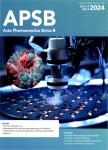The poly(ADP-ribosyl)ation of BRD4 mediated by PARP1 promoted pathological cardiac hypertrophy
The poly(ADP-ribosyl)ation of BRD4 mediated by PARP1 promoted pathological cardiac hypertrophy作者机构:Department of Pharmacology and ToxicologySchool of Pharmaceutical SciencesNational and Local United Engineering Lab of Druggability and New Drugs EvaluationGuangdong Engineering Laboratory of Druggability and New Drug EvaluationGuangdong Provincial Key Laboratory of New Drug Design and EvaluationSun Yat-sen UniversityGuangzhou 510006China Center for Cardiovascular Research and Division of CardiologyWashington University School of MedicineSt.LouisMO 63101USA International Institute for Translational Chinese MedicineSchool of Pharmaceutical SciencesGuangzhou University of Chinese MedicineGuangzhou 510006China
出 版 物:《Acta Pharmaceutica Sinica B》 (药学学报(英文版))
年 卷 期:2021年第11卷第5期
页 面:1286-1299页
核心收录:
学科分类:1007[医学-药学(可授医学、理学学位)] 1004[医学-公共卫生与预防医学(可授医学、理学学位)] 1002[医学-临床医学] 1001[医学-基础医学(可授医学、理学学位)] 10[医学]
基 金:supported by grants from the National Natural Science Foundation of China(81872860,81673433,and 81973318) Local Innovative and Research Teams Project of Guangdong Pearl River Talents Program(2017BT01Y093,China) National Major Special Projects for the Creation and Manufacture of New Drugs(2019ZX09301104,China) Special Program for Applied Science and Technology of Guangdong Province(2015B020232009,China) National Engineering and Technology Research Center for New drug Druggability Evaluation(Seed Program of Guangdong Province,2017B090903004,China) Guangdong Basic and Applied Basic Research Foundation(2019A1515011256,China) Guangzhou Science and Technology Program Project(201604020121 and 201804010227,China) Yang Fan Project of Guangdong Province(Grant No.2014YT02S044,China) Guangdong Provincial Key Laboratory of Construction Foundation(No.2017B030314030,China)。
主 题:BRD4 PARP1 PARylation Isoproterenol Cardiac hypertrophy RNA Pol II Transcription activation Hypertrophic genes
摘 要:The bromodomain and extraterminal(BET)family member BRD4 is pivotal in the pathogenesis of cardiac hypertrophy.BRD4 induces hypertrophic gene expression by binding to the acetylated chromatin,facilitating the phosphorylation of RNA polymerases II(Pol II)and leading to transcription elongation.The present study identified a novel post-translational modification of BRD4:poly(ADPribosyl)ation(PARylation),that was mediated by poly(ADP-ribose)polymerase-1(PARP1)in cardiac hypertrophy.BRD4 silencing or BET inhibitors JQ1 and MS417 prevented cardiac hypertrophic responses induced by isoproterenol(ISO),whereas overexpression of BRD4 promoted cardiac hypertrophy,confirming the critical role of BRD4 in pathological cardiac hypertrophy.PARP1 was activated in ISOinduced cardiac hypertrophy and facilitated the development of cardiac hypertrophy.BRD4 was involved in the prohypertrophic effect of PARP1,as implied by the observations that BRD4 inhibition or silencing reversed PARP1-induced hypertrophic responses,and that BRD4 overexpression suppressed the antihypertrophic effect of PARP1 inhibitors.Interactions of BRD4 and PARP1 were observed by coimmunoprecipitation and immunofluorescence.PARylation of BRD4 induced by PARP1 was investigated by PARylation assays.In response to hypertrophic stimuli like ISO,PARylation level of BRD4 was elevated,along with enhanced interactions between BRD4 and PARP1.By investigating the PARylation of truncation mutants of BRD4,the C-terminal domain(CTD)was identified as the PARylation modification sites of BRD4.PARylation of BRD4 facilitated its binding to the transcription start sites(TSS)of hypertrophic genes,resulting in enhanced phosphorylation of RNA Pol II and transcription activation of hypertrophic genes.The present findings suggest that strategies targeting inhibition of PARP1-BRD4 might have therapeutic potential for pathological cardiac hypertrophy.



